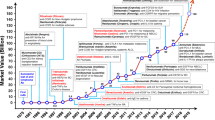Abstract
The variable regions of murine monoclonal anti-HBx immunoglobulin and the constant region of human antibody were cloned by reverse transcriptpolymerase chain reaction (RT-PCR). The heavy-chain and light-chain variable regions were connected and coexpressed with human constant region C-r3 and C-k3 in the reconstructed vector ofE. coli. The products showed high specificity and binding ability with HBx, which is closely associated with hepatocarcinogenesis. This makes it possible to humanize the mouse monoclonal antibodies and express the fusion protein inE. coli for potential radioimmunotherapy in patients with hepatocellular carcinoma.
Similar content being viewed by others
References
Arakawa F, Haruno M, Kuroki M, Kanda H, Watanabe T, Misumi Y, Matsuoka Y (1993) Construction and expression of two mouse-human chimeric antibodies with high specificity and affinity for carcinoembryonic antigen. Hybridoma 12:365–379
Chomczynski P, Sacchi N (1987) Single-step method isolation of RNA by acid guanidinium thiocyanate-phenol-chloroform extraction. Anal Biochem 162:156–159
Hilger C, Velhagen I, Zentgraf H, Schroder CH (1994) Diversity of hepatitis B virusX gene-related transcripts in hepatocellular carcinoma: a novel polyadenylation site on viral DNA. J Virol 65:4284–4291
Huston JS, Levinson D, Mudgett-Hunter M, Tai S, Novotny J, Margolies MN, Ridge RJ, Bruccoleri RE, Haber E, Crea R (1988) Protein engineering of antibody bind sites: recovery of specific activity in an anti-digoxin single-chain Fv analogue produced inEscherichia coli. Proc Natl Acad Sci USA 85:5879–5883
Jin BR, Ryu CJ, Park SS, Namgung U, Hong J, Han MH (1993) Cloning, expression and characterization of a murine-human chimeric antibody with specificity for pre-S2 surface antigen of hepatitis B virus. Mol Immunol 30:1647–1654
Li J, Tang ZY, Liu KD, Chen SL, Xu KP, Schroder CH (1994a) Radioimmunoimaging with monoclonal antibody to HBV X protein in nude mice bearing human hepatocellular carcinoma. Chin J Oncol 16:11–14 (in Chinese)
Li J, Tang ZY, Liu KD, Schroder CH (1994b) Preparation of monoclonal antibody directed against hepatitis B virus X protein and detection of reactive antigen in hepatocellular carcinoma (in Chinese). Natl Med J China 74:533–535
Li J, Tang ZY, Liu KD, Chen SL, Schroder CH (1995) Radioimmunoimaging of human hepatocellular carcinoma xenografts with 131-I-anti-HBx monoclonal antibody. J Exp Clin Cancer Res 14:25–30
Liu AY, Robinson RR, Hellstrom KE, Murray ED, Chang CP, Hellstrom I (1987) Chimeric mouse-human IgG1 antibody that can mediate lysis of cancer cells. Proc Natl Acad Sci USA 84:3439–3443
Lonberg N, Taylor LD, Harding FA (1994) Antigen-specific human antibodies from mice comprising four distinct genetic modifications Nature 368:856–859
McPherson MJ, Ouirke P, Taylor GR (eds) (1992) PCR, a practical approach. Oxford University Press, Oxford, pp 229–230
Orlandi R, Gussow DH, Jones PT, Winter G (1986) Cloning immunoglobulin variable domains for expression by the polymerase chain reaction. Proc Natl Acad Sci USA 86:3833–3837
Qin LX, Tang ZY, Liu KD, Xue Q (1995) Reconstitution of human immune system in SCID mouse with intraperitoneal injection of fetal liver cells. (in Chinese). Chin J Microbiol Immunol 15:272–275
Riechmann L, Clark M, Waldmann H, Winter G (1988) Reshaping human antibodies for therapy. Nature 332:323–327
Silverman GJ (1992) Human antibody responses to bacterial antigens: studies of a model conventional antigen and a proposed model B cell superantigen. Int Rev Immunol 9:57–78
Sambrook J, Fritsch EF, Maniatis T (eds) (1989) Molecular cloning: a laboratory manual, 2nd edn, vols 4, 18. Cold Spring Harbor Laboratory Press, Cold Spring Harbor, pp 21–37; 47–58
Sandhu JS (1992) Protein engineering of antibodies. Crit Rev Biotechnol 12:437–462
Tang ZY, Zeng ZC, Liu KD, Yu YQ, Lu JZ, Xie H (1993a) Intrahepatic arterial I-131 antihepatocellular carcinoma (HCC) monoclonal antibody combined with hepatic artery ligation for treatmant of unresectable HCC. Antibody Immunoconj Radiopharm 6:167–175
Tang ZY, Liu KD, Fan Z, Lu JZ, Zhang YJ, Bao YM, Zeng ZC, Zhou D, Tang WY, Xia XL, Yang, R, Li J, Wei C, Wu B, Lin ZY, Ma ZC, Zhou XD, Yu YQ, Yang BH, Zhao HY, Xie H, Schroder CH, Arosio P (1993b) A decade's studies on the immunotargeting therapy of hepatocellular carcinoma. Antibody Immunoconj Radiopharm 6:155–165
Verhoeyen M, Milstein C, Winter G (1988) Reshaping human antibodies: grafting human antilysozyme activity. Science 239:1534–1536
Author information
Authors and Affiliations
Rights and permissions
About this article
Cite this article
Zhou, G., Liu, KD., Tang, ZY. et al. Reconstruction and expression of chimeric anti-HBx antibody inEscherichia coli . J Cancer Res Clin Oncol 123, 325–330 (1997). https://doi.org/10.1007/BF01438308
Received:
Accepted:
Issue Date:
DOI: https://doi.org/10.1007/BF01438308




